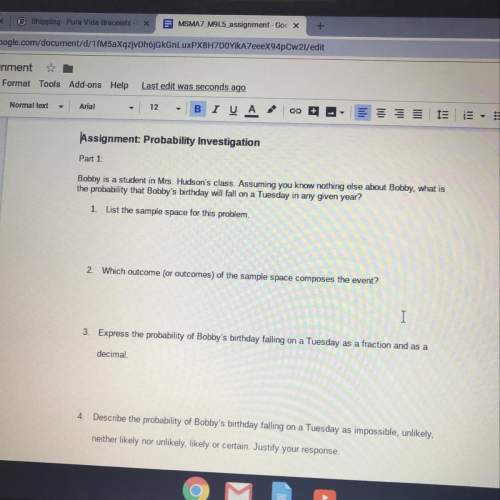
Mathematics, 28.02.2020 03:15 tiaharris3191
More than 96 percent of the very largest colleges and universities (more than 15,000 total enrollments) have some online offerings. Suppose you randomly pick 14 such institutions. We are interested in the number that offer distance learning courses.
Part (a) In words, define the Random Variable X.
1. the number of distance learning courses offered at each college or university
2. the percentage of colleges and universities that offer distance learning courses
3. the number of colleges and universities that offer distance learning courses
4. the number of colleges and universities in the United States
Part (b) List the values that X may take on.
1. X = 1, 2, 3, . . ., 95, 96
2. X = 1, 2, 3, . . ., 12, 13, 14
3. X = 0, 1, 2, . . ., 12, 13, 14
4. X = 0, 1, 2, 3, . . ., 95, 96
Part c. Give the distribution of X. (Enter exact numbers as integers, fractions, or decimals.)
X ~ ? ( , )
Part d. On average, how many schools would you expect to offer such courses? (Round your answer to the nearest whole number.)
schools
Part e. Find the probability that at most twelve offer such courses. (Round your answer to four decimal places.)
part f. Is it more likely that 13 or that 14 will offer such courses? Use numbers to justify your answer numerically and answer in a complete sentence.
The probability that 13 schools will offer such courses is ---Select--- 0.0892 0.3294 0.5647 0.6706 or 0.9108 and the probability that 14 schools will offer such courses is ---Select--- 0.0892 0.3294 0.5647 0.6706 or 0.9108 . Therefore, it is more likely that ---Select--- 13 or 14 schools will offer distance learning courses.

Answers: 3


Another question on Mathematics

Mathematics, 21.06.2019 19:10
What is the quotient of m^6/5 ÷ 5/m^2? assume m does not equal pl
Answers: 1

Mathematics, 21.06.2019 20:40
Ineed someone to me answer my question i have to have this done and knocked out
Answers: 2


Mathematics, 22.06.2019 00:30
1. according to the internal revenue service, the mean tax refund for the year 2007 was $2,708. assume the standard deviation is $650 and that the amounts refunded follow a normal probability distribution. a. what percent of the refunds are more than $3,000? b. what percent of the refunds are more than $3,000 but less than $4,000? c. what percent of the refunds are less than $2,000?
Answers: 2
You know the right answer?
More than 96 percent of the very largest colleges and universities (more than 15,000 total enrollmen...
Questions

Mathematics, 08.12.2020 05:30


English, 08.12.2020 05:30

Social Studies, 08.12.2020 05:30


Mathematics, 08.12.2020 05:30

English, 08.12.2020 05:30

Mathematics, 08.12.2020 05:30

Mathematics, 08.12.2020 05:30


English, 08.12.2020 05:30

History, 08.12.2020 05:30


History, 08.12.2020 05:30

Mathematics, 08.12.2020 05:30

Chemistry, 08.12.2020 05:30

Mathematics, 08.12.2020 05:30

Biology, 08.12.2020 05:30






